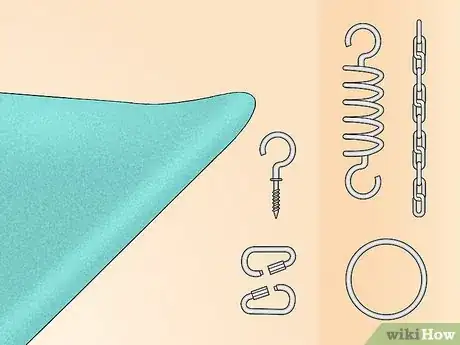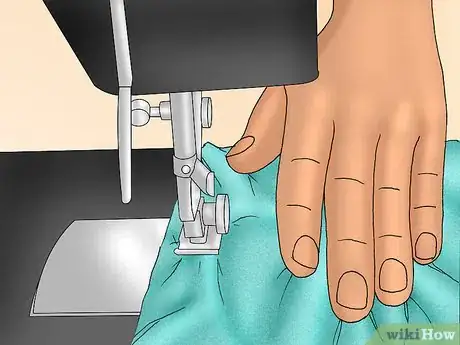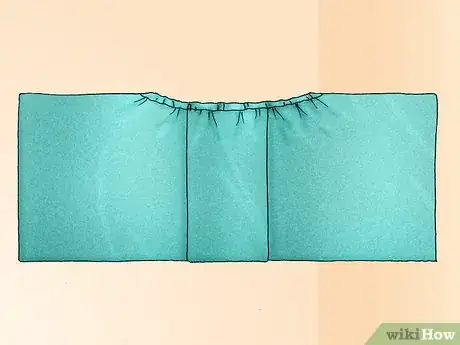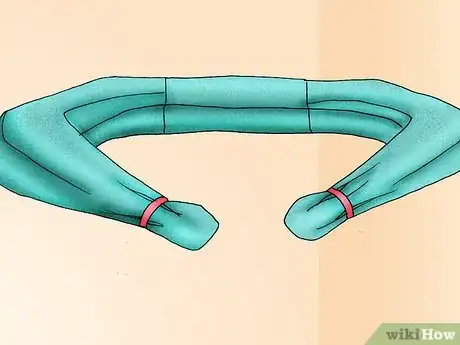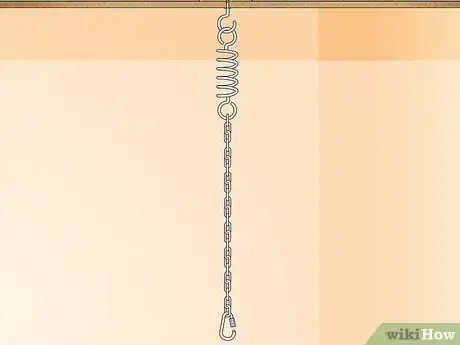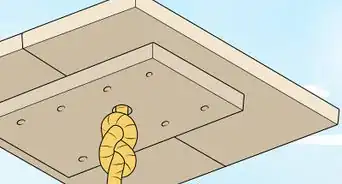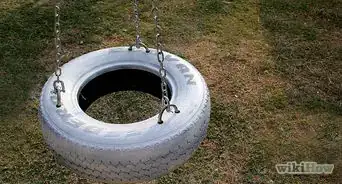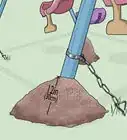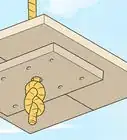X
wikiHow is a “wiki,” similar to Wikipedia, which means that many of our articles are co-written by multiple authors. To create this article, volunteer authors worked to edit and improve it over time.
This article has been viewed 86,056 times.
Learn more...
A baby hammock is a swing that you can buy in most baby supply stores, but you can also make one very easily at home for a fraction of the cost. Babies under the age of nine months enjoy lying in the hammock swing as it rocks them gently and keeps them entertained, while you are free to go about your daily chores.
Steps
Part 1
Part 1 of 2:
Making the Baby Hammock
-
1Gather your materials. Prepare everything you need to make the baby hammock swing before you start. You will need:
- 3 meters of strong, thick fabric, like muslin, 40 inches (101.6 cm) wide
- A 6 inch (15.2 cm) spring
- A hook
- A steel ring
- A chain
- A board:1 inch thick, 3 inches (7.6 cm) wide and 2 feet in length
- A snap hook or quick link
-
2Create the swing. The first thing you need to do is create the swing itself. Fold the edges of the fabric inwards by about 2 inches (5.1 cm) and sew all the way around.
- Spread the fabric flat on the ground, then fold it in half lengthwise. Sew the two edges together to create a big ring of fabric.
Advertisement -
3Create a bottom for the swing. Next, you need to make the bottom of your baby hammock swing. Measure 14 inches (35.6 cm) from the first seam and sew another seam at that place, across the width.
- Fold over those 14 inches (35.6 cm) of material and sew it in place. It needs to be attached to the rest of the fabric, to provide a reinforced bottom for the hammock swing.
-
4Add an elastic band to the hammock. Make a canal for the elastic at the top of the swing. Determine where the baby's head would be.
- Measure 8 inches (20.3 cm) on each side of the bottom center of your swing (the part with the 14-inch). On one side, fold over a ¾ inch strip fabric to create a channel for the elastic band.
- Insert the elastic band, sew it down on one end, then gather the material until it forms about 6 inches (15.2 cm) in total. Once you've gathered the material, sew the other end of the elastic in place. .
-
5Tie off the bottom of the hammock. Make ties at the bottom end of the hammock using bias tape. Use 13 inches (33.0 cm) of tape for each tie, then just knot the end.
- Find the center point at the bottom of the hammock and measure the 4 inch (10.2 cm), 8 inch (20.3 cm) and 12 inch (30.5 cm) points on either side. Mark these places.
- Sew the 13 inch (33.0 cm) ties on the underside of the swing at these spots.
-
6Make a pillow and pillowcase. Get the foam and cut a 14 x 30 inch piece to make a pillow. Make a pillowcase from the same fabric as the swing by measuring the size of the pillow.
- Cut out two pieces of fabric that are 1⁄2 inch (1.3 cm) larger than the measurement of the pillow on all sides and sew three of the sides together. If the fabric has a print, make sure its on the inside when you sew the edges
- Leave the fourth side of the pillowcase open. When you finish, turn the pillowcase right side out and insert the pillow.
- You can close the open side of the pillowcase by sewing on buttons or a zip.
Advertisement
Part 2
Part 2 of 2:
Installing the Hammock
-
1Decide where you would like to hang the swing. Find a good place in your home for the hammock swing. Once you've found an appropriate spot, drill a hole in the ceiling and insert a hook.
- Ensure that the ceiling is strong enough and make sure the hook is securely in place.
- Check the hole and the hook from time to time because as it can start to come loose after a lot of swinging.
- Make sure that there is space to swing. The swing must be at least 14 inches (35.6 cm) away from any barriers or hard surfaces, such as walls or edges of furniture.
- Hang the spring on the hook. The spring will allow the swing to gently bounce while swinging.
-
2Use a chain to hang the swing. Measure the length of the chain that you need, depending on how low you want to set the hammock swing. You shouldn't make the swing too high, in fact it should be relatively close to the floor.
- Measure from the top and do not forget to include the dimension of the swing in the measurement.
- Measure the height of your hammock swing from the steel ring to the bottom of the swing.
- Consider putting a mattress beneath the swing, that way if your baby falls they will not be hurt.
- Place the chain on the spring. At the other end put the carabiner or a quick link.
-
3Drill holes to hang the hammock from. Cut a "U" shape into each end of the wooden board. Each "U" should be ¾ inches wide and 1 ½ inches into the board.
- Pull the free ends of the swing fabric through these holes. Make sure the bottom of the swing is in the middle.
- Secure the ends of the fabric by tying them up with additional ties.
-
4Pull the free ends of the fabric through the steel ring. The steel ring should be in the middle of the fabric. Make sure the bottom of the swing is centered and that it stays flat.
- Secure the steel ring with another tie to make it more stable. Attach the steel ring onto a carabiner.
-
5Put your baby in the hammock. Place your baby's head where the elastic is, and your baby's legs where the tied strips are. Tie the straps that are stitched to the bottom of the swing together to close the swing and ensure that the baby does not fall out.
- Always put your baby lying on her back and check her from time to time. Do not leave the baby out of your sight.
- Make sure that the swing can stand your baby's weight. Before you put the baby in, test it out using a load that weighs the same as the baby.
Advertisement
Warnings
- Do not place additional pillows or blankets into the hammock as this can lead to suffocation.⧼thumbs_response⧽
- Do not continue to use the swing once your baby reaches 9 months of age. Babies are more agile and restless at this stage, and can easily roll over and fall out.⧼thumbs_response⧽
- Do not use Baby Hammock for nighttime sleep. Too much sleep on a soft surface may deform the baby's spine.⧼thumbs_response⧽
Advertisement
References
About This Article
Advertisement
